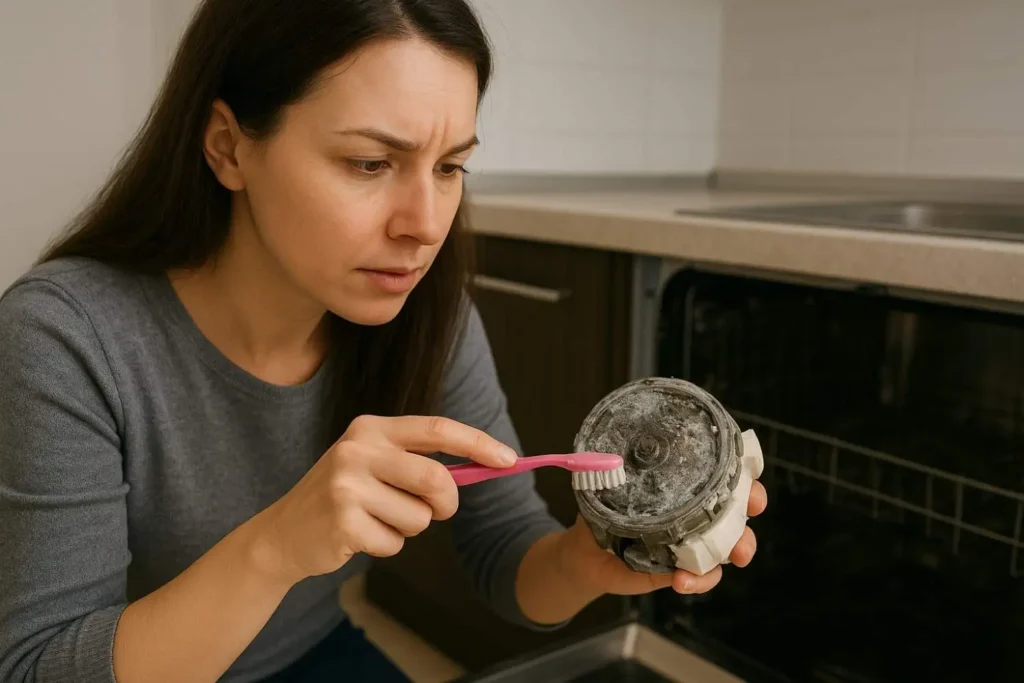A clogged or unclean motor may be the cause of your dishwasher’s inability to drain water or clean dishes effectively. The circulation and drain pumps that keep water moving through your appliance are powered by the motor. Performance may be impacted over time by blockages caused by mineral accumulation, grease, and food particles.
Follow this simple guide to clean your dishwasher motor safely and restore its efficiency.
Safety First
Disconnect the dishwasher and cut off the water supply before you start. This is necessary to avoid water leaks or electric shock while cleaning. To shield your hands from debris or sharp edges, put on gloves.
Tools You’ll Need
You don’t need any advanced tools — just the basics:
- Screwdrivers
- Pliers
- Wrenches
- Drill or bit set
- Old towel or blanket
Tip: Place the towel under your dishwasher to avoid scratching your floor while moving the unit.
Step 1: Remove the Dishwasher
The dishwasher is mounted beneath the countertop; begin by unscrewing the mounting brackets. Slide it out of its place gently. Check the water hose or leveling legs if it feels stuck; you might need to disconnect the hose or lower the legs for easier access.
Step 2: Access the Motor and Pump
Gently lay the dishwasher on its side. The motor and pump assembly can be accessed by removing the bottom access panel. The majority of dishwashers contain a drain pump to empty the dishwasher and a circulation pump to spray water.
Look for the pump that is connected underneath the tub; it is typically secured with a tiny twist mechanism or locking tab. To remove the pump and motor, release this.
Step 3: Clean the Motor
Disconnect the motor from the electrical harness after removing it. Using a moist cloth or paper towel, remove any visible dirt, debris, or food particles. Use warm, soapy water and a little brush to remove tenacious buildup.
Clean the impeller and casing after gently removing the screws if the motor housing’s interior appears unclean. Wipe and dry the electrical components thoroughly instead of soaking them.
Step 4: Clean the Drain Pump
Bad odors or poor drainage might also be caused by a clogged drain pump. Look for obstructions in the drain hose or impeller area. Before reassembling, make sure all parts are dry, remove any debris, and rinse with hot water.
Step 5: Reassemble and Test
Connect the electrical harness, firmly reattach the pump and motor, and then reposition the dishwasher. After turning on the power and water supplies, start a quick wash cycle. Check for leaks and listen for seamless operation.
The dishwasher may have a more serious electrical or mechanical problem if the problem continues or it still won’t start. For a more thorough diagnostic, get in touch with a qualified specialist.
Maintenance Tip
To prevent buildup, run a dishwasher cleaner or vinegar cycle every month. Regular maintenance helps extend your dishwasher’s life and keeps it running efficiently.
When to Call a Professional
If you notice burnt smells, unusual noises, or repeated motor failure, stop using the appliance and call a certified technician. Attempting advanced repairs without experience may cause damage or void your warranty.
Conclusion
Cleaning your dishwasher motor isn’t difficult if you follow the right steps and safety precautions. Regular cleaning keeps your appliance efficient, prevents drainage problems, and helps you avoid costly repairs in the long run.
